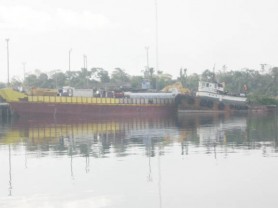Synergy Holdings Inc. was awarded the contract for phase one of the Amaila Falls Hydroelectric Project (AFHEP) after presenting evidence to the technical evaluators that persons with the expertise to complete the work would be hired, a source familiar with the process has disclosed.

Since the US$15.4 million contract was awarded to Fip Motilall’s Synergy Holdings, concerns have been raised about the company’s road building capacity. There is no evidence of the company ever having built a road. When asked about this, Head of the National Industrial and Commercial Investment Ltd (NICIL) Winston Brassington had said that Synergy had significant road building experience in the US states of Georgia and Florida.
When questioned about Motilall’s road building experience, the source told Stabroek News that the country’s procurement system allows anyone interested to bid as a contractor. Regarding road building projects, the source explained that “anybody can be a contractor…that contractor doesn’t have to have road building experience.” The source, however, said that the onus would be on the contractor to explain and to provide evidence how he or she intends to complete the project should it be awarded. The source said that this would explain how Synergy Holdings would have won the contract to build the access roads for the project.
A senior official from the Public Works Ministry when contacted yesterday on the matter said that the road project would be overseen by a team of “reputable supervisors” who “have all sorts of experience.” The official, who requested anonymity, did not disclose who these supervisors are but said that the persons working on the project would be those hired by Synergy Holdings.
The Request for Proposals (RFP) for this phase of the project said that the interested contractor was required to identify similar large scale project experience over the previous five (5) years, citing “examples of scope of work, project location and costs,” as well as “references and credentials… including contact information for project managers and/or owners with whom [he] has worked.” Additionally, the potential contractor was required to submit details on the equipment and machinery that he owned and which would be needed. Where the contractor intended to sub-contract the use of equipment and machinery, a copy of the agreement between the contractor and the sub-contracted party had to be submitted.
Additional requirements were the submission of the contractor’s financial and human resource capability to undertake the project and the provision of resumés of the proposed individuals who were likely to be permanently or partially attached to the project.
Further “details of the contractor’s past experience and capacity to effectively manage environmental, social and worker health and safety impacts and risk on similar projects consistent with World Bank Standards,” were requested.
When President Bharrat Jagdeo was questioned about the contract award recently he said it had been granted after an evaluation by team of technical evaluators and suggested that he would have them provide information to the media on the grounds which the company was awarded the contract.
The President subsequently told reporters to contact engineer Walter Willis, who was a member of the Technical evaluators, for more information on the award of the contract. However, Willis when contacted by the newspaper said he had not received any instruction from the Head of State.
Meanwhile, the start of the road project may be nearer, after the barge transporting most of the required equipment arrived in the country on Sunday. Reports reaching this newspaper are that the first batch of equipment arrived at the Guyana National Industrial Corporation (GNIC) wharf and was transported to Linden yesterday morning. According to reliable sources, the equipment that arrived consisted of machines for road clearing and sub-base preparations. All the equipment is expected to be offloaded by today, this newspaper was told.
When construction begins, the road will start from the Wisroc junction and proceed 26 miles along the Linden/Mabura road before turning off at Butakari in the Essequibo. From there, it will go by the village of Kaburi and will follow the trail up the AFHEP.
The road is expected to be built in such as way as to follow contours and to avoid swamps as well as rivers and ravines. It will be designed for axel loads of 20 tonnes and the bridges and pontoon crossing will be constructed for weights of up to a 100 tonnes, in keeping with the requirements of the contractors who are building the hydropower plant.
The first phase of the AFHEP includes “the upgrading of approximately 85 km of existing roadway, the design and construction of approximately 110 km of virgin roadway, the design and construction of two new pontoon crossings at the Essequibo and Kuribrong rivers.”
The fourth part of the project is for the clearing of a pathway alongside the roadways to allow for the installation of approximately 65 km of transmission lines.





